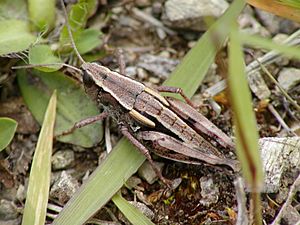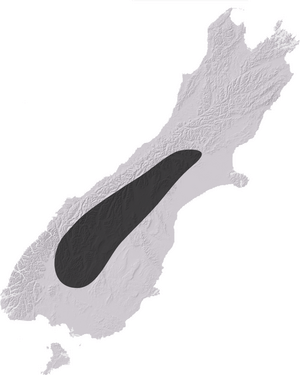Sigaus australis facts for kids
Quick facts for kids Sigaus australis |
|
|---|---|
 |
|
| A female Sigaus australis | |
| Scientific classification | |
| Kingdom: | |
| Phylum: | |
| Class: | |
| Order: | |
| Family: | |
| Genus: |
Hutton, 1897
|
| Species: |
S. australis
|
| Binomial name | |
| Sigaus australis (Bigelow, 1967)
|
|
 |
|
| The distribution of Sigaus australis in New Zealand | |
Sigaus australis is the most common alpine grasshopper found in New Zealand. It can be found in the southern half of the South Island above the tree line. Sigaus australis was described in 1897 by Frederick Hutton. Like all of New Zealand sub-alpine and alpine grasshoppers S. australis has a 2 or 3 years life cycle. Individuals can survive the cold by freezing solid at any life stage, at any time of the year. Sigaus australis adults are relatively large grasshoppers (females ~ 26mm). The genus Sigaus is endemic to New Zealand.
Distribution and habitat
Sigaus australis can be found in the southern half of the South Island, from Otago and Canterbury regions. It can be found as far south as the Kawarau River (45°49′43″S 168°58′02″E / 45.828700°S 168.967102°E) and as far north as the Torless Range (43°14′39″S 171°48′34″E / 43.244052°S 171.809578°E). Sigaus australis prefer tussock grasslands between 1,300–1,700 metres (4,300–5,600 ft) elevation, however, can be found as low as 200 metres (660 ft) on the Alexandra Tailings, (45°14′49″S 169°22′07″E / 45.246895°S 169.368559°E) and as high as 2,000 metres (6,600 ft) on Smite Peak (43°21′10″S 171°14′17″E / 43.35276073°S 171.2380887°E). Evidence from mtDNA sequencing suggests that S. australis encompasses several narrow endemic taxa and one widespread species.
Species description
The wings on S. australis are micropterous (small wings) between 2–4 millimetres (0.079–0.157 in) making this species flightless like most of New Zealand grasshoppers. Sigaus australis is highly cryptic, there is no polymorphism within this species. They will match the surrounding vegetation with colours of earth tones.
Type Information
Paprides australis Hutton (1897:147)
- Hutton, F.W. 1897: The grasshopper and locusts of New Zealand and the Kermadec Island. Proc. Trans. NZ Inst. 30: 135-50
- Type locality: Probably from Glenorchy, Lake Wakatipu, Otago. 44°51′05″S 168°23′16″E / 44.851478°S 168.387771°E.
- Type specimen: Female; C Chilton; Holotype and Lectotype are deposited in the Canterbury Museum, Christchurch.
Paprides torquatus Hutton (1898:47)
- Hutton, F.W. 1898: Notes on the New Zealand. Proc. Trans. NZ Inst. 31: 44-50
- Type locality: Probably from Mount Torlesse, Canterbury. 43°15′23″S 171°49′16″E / 43.256418°S 171.821165°E.
- Type specimen: Male; Holotype deposited in the Canterbury Museum, Christchurch.
Paprides armillaus Hutton (1898:47-48)
- Hutton, F.W. 1898: Notes on the New Zealand. Proc. Trans. NZ Inst. 31: 44-50





